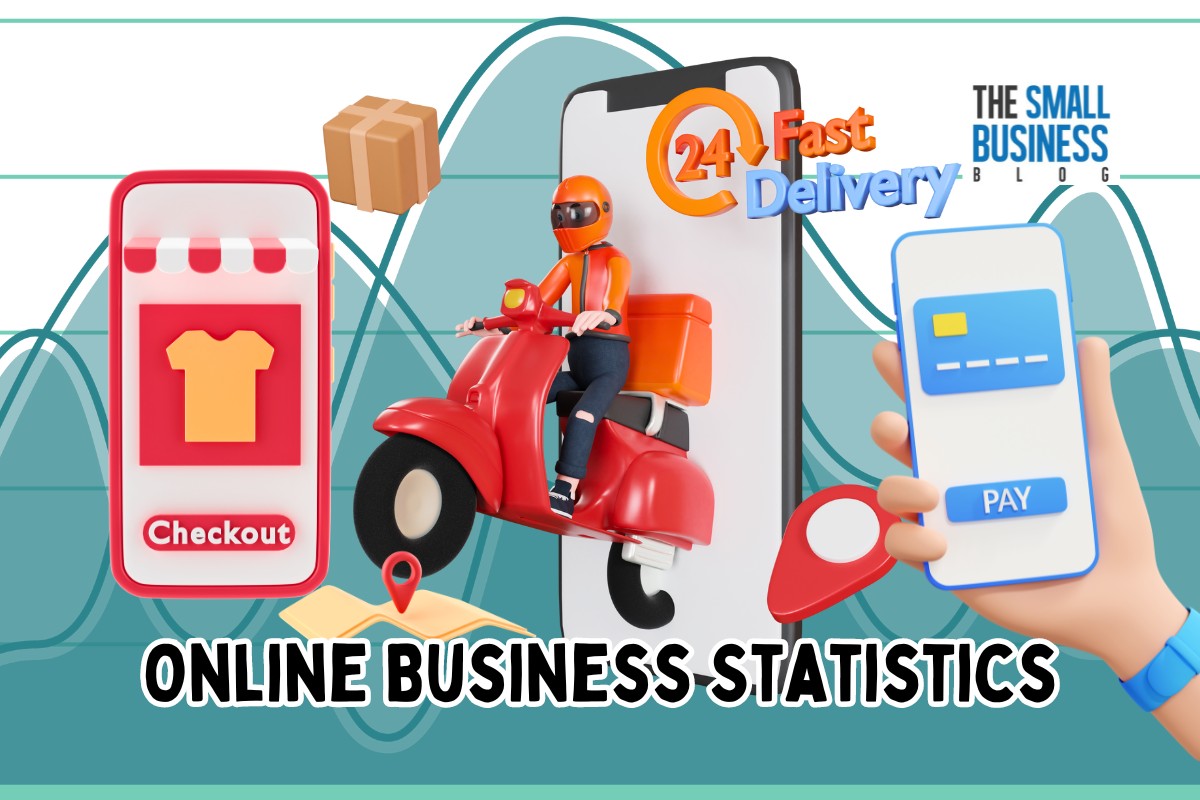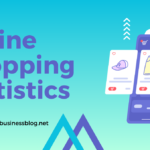The internet has changed the world of commerce.
We have come a long way since the first online marketplace, the Boston Computer Exchange, in 1979.
Today, everything you can think of is sold over the internet.
The best thing?
It will be delivered right in front of your doorstep in minutes!
In this article, we will dive into some of the most essential online business statistics in 2023, including the number of online stores, consumer behaviors, and marketing trends in the e-commerce sector.
Post Contents
- 1 Key Statistics
- 2 Online business statistics of 2024
- 2.1 1. The number of e-commerce sites worldwide is staggering, with estimates ranging from 12 to 24 million in 2023.
- 2.2 2. Approximately 2.5 million online businesses are operating in the United States
- 2.3 3. The digital shopping revolution has captivated an impressive 1.79 billion individuals worldwide
- 2.4 4. In 2023, e-commerce is projected to generate $6.3 trillion in global sales, representing 21.2% of the total retail market
- 2.5 5. More than two-thirds of small businesses worldwide have their own websites
- 2.6 6. Around 79% businesses with a website are expected to grow by 25% in the next three to five years
- 2.7 7. 85% of small businesses with websites have dedicated employees to manage their online presence
- 2.8 8. Nearly one in six Americans make weekly purchases through different online platforms
- 2.9 9. Online shopping surged dramatically with a 74% increase from March 2019 to March 2020
- 2.10 10. Around 30% of American business activities are conducted through multiple digital channels
- 2.11 11. United States daily online sales hit a 110% growth in April 2020
- 2.12 12. Before making a purchase, 8 out of 10 shoppers choose to do online research about the product or the service
- 2.13 13. Nearly one-third of those who have experienced online shopping favor it over the traditional shopping
- 2.14 14. Nearly one in five local mobile searches directly translates into a sale
- 2.15 15. Among all categories, gardening essentials witnessed the most significant demand growth during the pandemic
- 2.16 16. The online shopping landscape is dominated by Millennials, and 85.9% of them have shopped online
- 2.17 17. The harsh reality of the e-commerce world is that up to 90% of start-up businesses fail
- 2.18 18. Poor quality product promotion leads to e-commerce startup failure
- 2.19 19. 70% of individuals have expressed their confidence that digital payment methods will surpass cash and cards by 2030
- 2.20 20. Amazon’s financial prowess is reflected in its staggering market capitalization of $1.597 trillion in 2020
- 2.21 21. Among all the online purchases, 48.7% are made by women.
- 2.22 22. Three-quarters of online shoppers demand prompt assistance
- 2.23 23. Over half of all businesses have shifted their primary mode of customer interaction to the online world
- 2.24 24. 61% of marketers admitted that the most pressing challenge lies in attracting visitors and generating qualified leads for their websites.
- 2.25 25. Content marketing has firmly established itself as a prevalent strategy among brands
- 2.26 26. Majority of marketers, about 65% have embraced the power of video marketing, integrating it into their content marketing strategies.
- 2.27 27. 80% of brands leverage affiliate partnerships to expand their customer base and generate revenue.
- 3 Conclusion
Key Statistics
- There are about 12 to 14 million online stores available in the market in 2023.
- A whopping 1.79 billion people worldwide have shopped online in 2022.
- The e-commerce sector is projected to generate $6.3 trillion revenue.
- 71% of businesses worldwide have their own websites available for their customers.
- 81% of consumers conduct product research before making a purchase.
- 34% of online shoppers prefer shopping online vs. shopping in physical shops.
- 90% of start-up businesses are most likely to fail after a few years.
- 65% of marketers recognized the importance of video marketing today.
Online business statistics of 2024
1. The number of e-commerce sites worldwide is staggering, with estimates ranging from 12 to 24 million in 2023.

The e-commerce industry has recorded an impressive growth in recent years, driven by the convenience and accessibility of online shopping.
In 2023, it is estimated that there are between 12 and 24 million e-commerce sites operating all over the world.
Retail e-commerce sales during the year came at 6.3 billion, up from 5.7 billion in 2022 and 5.2 billion in 2021.
(Zippia)
2. Approximately 2.5 million online businesses are operating in the United States
The United States is one of the global leaders in the e-commerce sector, having an estimated 2.5 million online businesses operating in the country.
The US is also one of the fastest-growing online commerce regions in the world, with a projected compounding annual growth rate of 11.22% in retail sales between 2023 to 2027.
(EtailInsights)
3. The digital shopping revolution has captivated an impressive 1.79 billion individuals worldwide
The allure of online shopping has resonated with 1.79 billion people worldwide, making it their preferred method of acquiring goods and services in the previous year.
This shift towards digital commerce has been driven by several factors, including the increased internet penetration, convenience, wider product selection, personalized product recommendations, and easier returns policy.
Here are the leading e-commerce companies worldwide in 2022:
- Amazon.com – the platform had a market capitalization of 857 billion during the year
- Alibaba – the platform had a market capitalization of 233 billion during the year
- PinDuoDuo – the platform had a market capitalization of 103 billion during the year
- Prosus – the platform had a market capitalization of 91 billion during the year
- JD.com – the platform had a market capitalization of 88 billion during the year
- Booking.com – the platform had a market capitalization of 78 billion during the year
- Airbnb – the platform had a market capitalization of 54 billion during the year
- Recruit – the platform had a market capitalization of 51 billion during the year
- Uber – the platform had a market capitalization of 49 billion during the year
- Shopify – the platform had a market capitalization of 44 billion during the year
- Mercado libre – the platform had a market capitalization of 43 billion during the year
(First site guide and Statista)
4. In 2023, e-commerce is projected to generate $6.3 trillion in global sales, representing 21.2% of the total retail market
E-commerce is poised to reach a monumental $6.3 trillion by the end of 2023, capturing a substantial 21.2% share of the global retail landscape.
Take a look at the retail e-commerce sales from 2018 to 2022, and projected figures from 2023 to 2026:
- 2018 – retail e-commerce sales stood at $2.9 trillion during the year
- 2019 – retail e-commerce sales stood at $3.3 trillion during the year
- 2021 – retail e-commerce sales stood at $4.2 trillion during the year
- 2022 – retail e-commerce sales stood at $5.2 trillion during the year
Projections for 2023 to 2026:
- 2023 – the projected retail e-commerce sales for the year is $6.3 trillion
- 2024 – the projected retail e-commerce sales for the year is $6.9 trillion
- 2025 – the projected retail e-commerce sales for the year is $7.5 trillion
- 2026 – the projected retail e-commerce sales for the year is $8.1 trillion
(Shopify)
5. More than two-thirds of small businesses worldwide have their own websites

The widespread adoption of websites by small businesses worldwide is a remarkable transformation in the global business industry.
71% of small businesses are now their own websites, reflecting the profound impact of technology on the way businesses operate and connect with their customers.
On the other hand, the biggest e-commerce platforms retain a lion’s share of the overall website traffic in the industry.
Below is the list of the world’s biggest e-commerce companies and their respective monthly website traffic in 2022.
- Amazon.com – the website averaged 3.1 billion monthly website visits during the year
- Ebay.com – the website averaged 589 million monthly website visits during the year
- Walmart.com – the website averaged 581 million monthly website visits during the year
- Aliexpress.com – the website averaged 486 million monthly website visits during the year
- Etsy.com – the website averaged 467 million monthly website visits during the year
- Amazon.de – the website averaged 340 million monthly website visits during the year
- Rakuten.co.jp – the website averaged 278 million monthly website visits during the year
- Homedepot.com – the website averaged 200 million monthly website visits during the year
- Target.com – the website averaged 194 million monthly website visits during the year
(Forbes)
6. Around 79% businesses with a website are expected to grow by 25% in the next three to five years
79% of businesses with websites foresee a successful future, anticipating a 25% growth surge in their businesses within the next three to five years.
Well, this is in response to the projection showing that 24% of all retail purchases worldwide will take place online by 2026.
By the end of this year, analysts noted that 8% of all retail purchases will be placed within the internet.
(Zippia)
7. 85% of small businesses with websites have dedicated employees to manage their online presence
85% of small businesses with websites have chosen to employ individuals to handle the upkeep and optimization of their online platforms.
This investment will likely lead to a good ROI as good ranking is equivalent to good sales nowadays.
According to LinkedIn, more than 50% of consumers will turn online to look for reviews and recommendations before clicking the pay button.
(Agility PR)
8. Nearly one in six Americans make weekly purchases through different online platforms
The digital marketplace has gained a strong foothold among Americans.
In fact, 15% of Americans admitted that they shop online on a weekly basis, showing the significant impact of e-commerce on consumer behavior and the economy of the region.
(Pew Research Org)
9. Online shopping surged dramatically with a 74% increase from March 2019 to March 2020
The COVID-19 pandemic accelerated the adoption of e-commerce, placing online transaction volumes in most retail sectors to soar by 74% between March 2019 to March 2020.
The surge of the pandemic ushered in a new era of consumer behavior, leading to an exponential growth in e-commerce and a permanent transformation of the retail landscape.
The lockdowns shifted attention away from in-store shopping, leaving consumers with no choice but to turn to online platforms to fulfill their purchasing needs.
(ACI Worldwide)
10. Around 30% of American business activities are conducted through multiple digital channels

A whopping 29.7% of American businesses have embraced the convenience and efficiency of online transactions, demonstrating the widespread integration of different online platforms into the business world.
(Zippia)
11. United States daily online sales hit a 110% growth in April 2020
In April 2020, the United States experienced an unexpected surge in e-commerce, with daily online sales skyrocketing by a staggering 110%.
The positive development carries through until today, with the Census Bureau of Commerce estimating a $284 billion US e-commerce retail sales for the third quarter of 2023.
(Tech Crunch)
12. Before making a purchase, 8 out of 10 shoppers choose to do online research about the product or the service
Consumers have become increasingly comfortable with online shopping and rely heavily on the internet for information that will guide their purchasing decisions.
Today, 81% of consumers are trying to do their personal research about the product or the brand before making a purchase.
More than 50% of these will turn to reviews and recommendations for added inputs, while 47% will personally visit a company’s website to find out more information about their intended purchase.
(Saleslion)
13. Nearly one-third of those who have experienced online shopping favor it over the traditional shopping
Online shopping offers consumers the convenience of shopping from anywhere, at any time, without the need to visit physical stores and walk hundreds of steps to go from one shop to another.
This eliminates the hassle of commuting to stores, dealing with crowds, and navigating store layouts.
It comes with no surprise that 34% of those who have shopped online prefer it over shopping in physical stores.
(Zippia)
14. Nearly one in five local mobile searches directly translates into a sale
The immediacy of local mobile searches is evident in the fact that 18% of these searches result in a purchase within 24 hours, showcasing the growing trend of impulse buying through mobile devices.
(Sagapixel)
15. Among all categories, gardening essentials witnessed the most significant demand growth during the pandemic

With lockdowns and social distancing measures in place, individuals spent more time at home, leading to a renewed interest in outdoor activities and DIY projects.
One of the most common hobbies that emerged during the pandemic lockdown is gardening.
Garden essentials emerged as the frontrunners in demand growth, experiencing a remarkable 163% surge since March 2019.
(Social Pakora)
16. The online shopping landscape is dominated by Millennials, and 85.9% of them have shopped online
Among all other generations, millennials have emerged as the most influential demographic in the online shopping landscape.
Their digital fluency, willingness to embrace new technologies, and preference for convenience have propelled them to the forefront of e-commerce.
This year, an estimated 85.9% of millennials will shop online.
59% of people in this age demographic will head to Amazon.com before going to other websites, making the Bezos-founded company one of the go-to platforms for online sales.
In 2021, 55% of people aged 18 to 24 years old in the United States placed at least an order via a social platform.
(Saleslion)
17. The harsh reality of the e-commerce world is that up to 90% of start-up businesses fail
The e-commerce landscape is a dynamic and competitive environment, offering immense opportunities for success but also presenting significant challenges.
While the allure of online entrepreneurship draws many aspiring business owners, the reality is that a staggering 90% of e-commerce start-ups fail within their first few years of operation.
18. Poor quality product promotion leads to e-commerce startup failure
Here are the leading reasons behind the failure of many startups in the e-commerce industry.
- Poor quality product promotion. A bad presentation and promotion of a product will most likely fail to capture the attention of potential customers. Nowadays, consumers are all about visuals. This is one of the reasons my successful startups invest heavily on good quality marketing materials.
- Ignoring the importance of SEO. Neglecting search engine optimization (SEO) practices leaves websites stranded in the vast expanse of the internet, unable to attract organic traffic, and capture the attention of search engine users.
- Venturing into oversaturated niches. Operating in already crowded market segments demands differentiation and strategic positioning to stand out from the crowd and capture a share of the market.
(Failory)
19. 70% of individuals have expressed their confidence that digital payment methods will surpass cash and cards by 2030
The growing preference for digital payment methods is a significant trend shaping the future of commerce and financial transactions.
In fact, 70% of individuals anticipate a shift towards digital payment methods, predicting their widespread adoption over traditional forms of payment by 2030.
Digital payment methods offer consumers the convenience of making payments without the need for physical cash or cards, simplifying the transaction process and reducing the risk of loss or theft.
(First Site Guide)
20. Amazon’s financial prowess is reflected in its staggering market capitalization of $1.597 trillion in 2020
Amazon’s market capitalization is a key indicator of its financial strength and market position.
In 2020, Amazon reached an astounding $1.597 trillion in value, making it one of the most valuable companies in the world.
The platform has revolutionized the e-commerce landscape, providing a seamless and convenient online shopping experience for consumers worldwide.
Its vast product selection, competitive pricing, and reliable delivery services have made it the go-to destination for online shoppers, especially in its home country, the United States.
(First Site Guide)
21. Among all the online purchases, 48.7% are made by women.

The common perception that women dedicate more time to shopping is challenged by data showing that only 48.7% of online shoppers are women, implying that men constitute the larger group at 51.3%.
(First Site Guide)
22. Three-quarters of online shoppers demand prompt assistance
The urgency for instant online assistance is evident as 75% of customers demand resolution to their issues within a quick five-minute window.
Customers increasingly expect prompt and effective assistance when shopping online, and their patience for delayed responses is waning.
(McKinsey)
23. Over half of all businesses have shifted their primary mode of customer interaction to the online world
The rapid advancement of technology and the widespread adoption of digital platforms have revolutionized the way businesses interact with their customers and clients.
Approximately 51% of businesses have embraced the digital landscape for customer interaction in 2023, recognizing the advantages and benefits it offers.
The shift towards online customer interaction has been particularly pronounced in recent years, accelerated by the COVID-19 pandemic.
With social distancing measures and pandemic-related restrictions, businesses were forced to adapt their operations and rely heavily on online channels to maintain customer engagement and sales.
(Meta)
24. 61% of marketers admitted that the most pressing challenge lies in attracting visitors and generating qualified leads for their websites.
In the digital age, where businesses increasingly rely on online platforms to reach their target audience, website traffic and lead generation have become essential metrics for measuring marketing success.
However, attracting visitors to websites and converting them into qualified leads remains a persistent challenge for marketers worldwide.
According to a recent survey, 61% of marketers identify website traffic and lead generation as their most pressing concern.
To ensure that leads are coming to one’s website, marketers continuously adapt their strategies and embrace new technologies to navigate the ever-changing nature of website traffic and lead generation.
(Thrive My Way)
25. Content marketing has firmly established itself as a prevalent strategy among brands
Content marketing has emerged as a powerful and widely adopted marketing strategy, with a significant 82% of brands actively implementing content marketing campaigns.
This type of marketing provides brands with a direct channel to connect with their target audience, fostering engagement and brand awareness through valuable and relevant content.
(Thrive My Way)
26. Majority of marketers, about 65% have embraced the power of video marketing, integrating it into their content marketing strategies.

Video marketing has established itself as a dominant force in the marketing landscape, with a staggering 65% of marketers embracing its power and seamlessly weaving video content into their content marketing strategies.
Videos have an unmatched ability to capture the attention of viewers, making them an effective tool for conveying messages and engaging target audiences.
In addition, it allows brands to tell compelling stories which creates a deeper connection with viewers and leaves a lasting good impression.
(Thrive My Way)
27. 80% of brands leverage affiliate partnerships to expand their customer base and generate revenue.
Affiliate marketing has emerged as a highly effective marketing strategy, with 80% of brands actively utilizing affiliate programs to expand their reach, acquire new customers, and drive revenue growth.
Affiliate partnerships enable brands to tap into the networks and audiences of established affiliates, expanding their reach beyond traditional marketing channels and gaining access to new customer segments.
(Thrive My Way)
Conclusion
The internet has demolished geographical constraints, giving rise to a boundless virtual marketplace where consumers can seamlessly browse, compare, and purchase products from the convenience of their homes.
By looking at these online business statistics, we can gain valuable insights into the current state of the e-commerce industry, information about consumer behavior, and assess the potential success of new business ventures in the ever-changing digital marketplace.






























